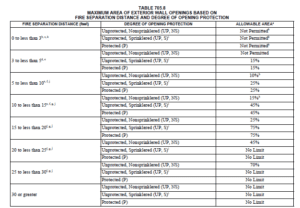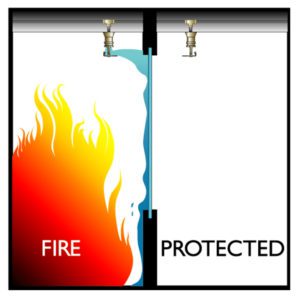Sprinkler Advantages for Exterior Openings
Exterior openings are important to any building. All joking aside, these openings are necessary for every building that has every existed and ever will exist into the future. These openings are how you access the interior, as well as how natural sunlight provides lighting to the buildings, via doors and windows among other important functions.
Openings in an exterior wall typically consist of windows and doors. Occasionally, air openings such as vents are also present. Depending on where a building is located, in relation to its lot lines, determines whether or not openings are required to be protected or even permitted. The maximum area of either protected or unprotected openings permitted in each story of an exterior wall is regulated by Section 705.8 of the 2018 International Building Code (IBC). It is understandable how using this tradeoff will allow you move a building around on a lot, as well as the effect on the exterior aesthetics.

Image courtesy of the International Code Council
The term protected in this section refers to those elements such as fire doors, fire windows, and fire shutters are regulated in Section 716 of the 2018 IBC. Protected openings have the mandated fire protection rating necessary to perform their function. Unprotected openings are simply those exterior openings that do not qualify as protected openings. As the fire separation distance increases, the percentage of opening is permitted to increase in compensation. At greater distances, the limit on the percentage of opening protection is eliminated. Long story short, the further away you are the from the lot line the more unprotected openings are permitted.
Let’s answer the prevailing question. How are exterior openings regulated in fully sprinklered buildings? Table 705.8 also recognizes an increase in the allowable area of unprotected exterior openings for those buildings that are provided with an automatic sprinkler system throughout. For example, the fire resistance rated exterior wall of a fully sprinklered building with a fire separation distance of 15 feet may have 75% of its surface area consisting of unprotected openings. If the building is not sprinklered, the limit on unprotected openings is only 25%. In other than higher Group H occupancies, the maximum permitted area of unprotected openings in an exterior wall is allowed to the same as the tabulated limitations for protected openings, provided the building is protected throughout with an NFPA 13 automatic sprinklers system. As you can see, the increased areas permitted due to sprinkler protection are all incorporated directly into Table 705.8. It is important to note that the presence of an automatic sprinkler system does not increase the maximum allowable opening area for protected openings. Section 716 is referenced for opening protection and addresses fire windows, fire doors, and fire shutters. The use of sprinklers and water curtains to eliminate the required opening protection is addressed in the exception. It indicates that where the building is sprinklered throughout, those openings protected by an approved water curtain do not need to be fire protective assemblies. This is accomplished by a couple of acceptable methods. One of the key words here is “automatic sprinklers” and the other is “water curtain”. The listed window sprinkler meets this criterion as well as a deluge water curtain with nozzles or open sprinklers designed to NFPA 13, Section 11.3.3. The code is providing this exception to wet the entire surface of the glass to meet the “protected” criteria in lieu of installing fire-rated glazing. However, the exceptions have virtually no application when the provisions of Table 705.8 are implemented, as the table allows for the elimination of protected openings in sprinklered buildings, without the need for water curtains. Additionally, the use of sprinkler system also eliminates the requirement to use the vertical separation of openings between floors.

Image courtesy of Johnson Controls
Using these sprinkler tradeoffs is a major advantage in the design phase. These tradeoffs can provide a major cost savings in the overall construction project. Especially when you compile them with many additional sprinkler tradeoffs which can be found in the, “NFSA Sprinkler Guide: 2018 International Building Code Edition.” We will continue discussing these tradeoffs in detail in future blogs.
